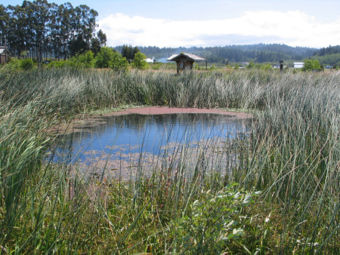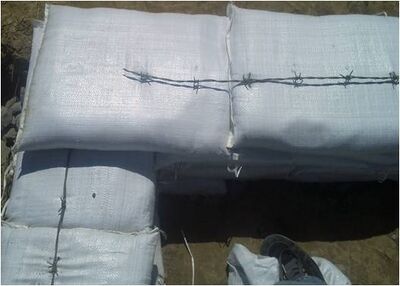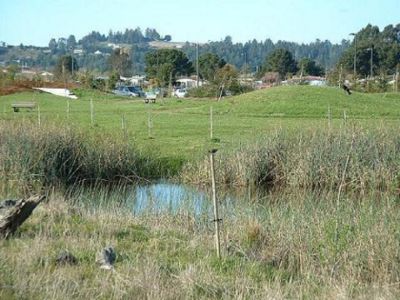| (2 intermediate revisions by the same user not shown) | |||
| Line 68: | Line 68: | ||
<gallery> | <gallery> | ||
Image:Pond | Image:Pond closest to Health Center.JPG| Pond closest to Health Center | ||
Image:| | Image:Debris by pond.JPG| Metal mesh and biomass next to pond | ||
Image:| | Image:Metal mesh material in pond.JPG| Small piece of metal mesh material in pond | ||
</gallery> | </gallery> | ||
Revision as of 23:15, 19 October 2014
Treatment Pond - Purpose

As a part of a much larger storm water treatment system at Potawot, the storm water treatment pond [FIG 1] treats 100 percent of the water that is channeled into the system. This water comes from parking lot and building runoff from storms. The water is anything but ready to be reintroduced to the ecosystem. The pond's first purpose is to filter the water in a natural way. The pond acts as a natural sponge by removing toxins without harming the environment. Then the water can be reintroduced to the Storm water - Seasonal Wetlands through a culvert. [1][2]
The second purpose of the treatment pond is to encourage natural habitat. The pond's design includes raised islands which create a resting place for water fowl. It is also home to the Three Spine Stickleback, a highly adaptive 6-10 cm long fish, which is indigenous to Humboldt County. Two other indigenous species that the pond is home to are the Red Legged Tree-Frog and the Western Frog. This is to promote sustainability of the environment at Potawot. [1]
Design - How It Works
Potawot swales channel storm water directly into the treatment pond. The water travels both above the ground surface and below. As the water reaches the pond, aerobic treatment begins on the surface. At the bottom of the pond, metals settle out and collect. [1][2]
The pond's center is the deepest point where the depth ranges from 5-6 feet. The edges are extremely shallow, between 2-3 feet deep, to allow plants to grow naturally there. This is so that the water gets circulated throughout plant matter on the outer part of the pond, creating a flowing cycle. This circulation is called the pond's "fetch." Bacteria thrive on the parts of the plants that are submerged in the pond. These bacteria eat and digest the polluting chemicals. Chemicals from Potawot are composed of average storm water byproducts plus the presence of oil from the parking lot runoff. More specifically, the storm water treatment pond is there to treat alkalinity, BOD5, chloride, COD, suspended solids, settleable solids, total dissolved solids, and trace amounts of other harmful chemicals. The treatment process decontaminates the water over time. [1][3]
Plants that are used in the treatment pond include:
- Scirpus Microcarpus (Small Fruited Bulrush)
- Scirpus Acutus (Soft Stemmed Bulrush)
- Carex Obnupta (Slough Sedge)

- Juncus Effuses (Juncus)
- Aleopecirous Geniculatus (Water Foxtail)
- Glyceria Occidentalis ( Western Manna Grass)
- Equisetum Hymale (Scouring Sedge)
- Mimulus Gutatus (Yellow Monkeyflower)
- Salix (Willow; various species)
- Spirea Douglasii (Hardhack)
- Potamogeton Natans (Floating-Leaved Pondweed)
- Nuphar Polysepalum (Yellow Pond-Lily) [1]
Cleaned water flows into a box which rests half-submerged in the treatment pond. This moves the water to a culvert that drains into the Storm water - Seasonal Wetlands of Potawot where it is reintroduced to the natural ecosystem. [1]
The pond was designed with Franciscan Mirage (also called "blue glue"), a hard clay. This clay layer acts as a barrier under the pond, soil, and vegetation to prevent toxins as well as water from escaping the area. The image [FIG 2] shows excavation done before laying the clay layer. [1]
Location - Potawot

Potawot is located in Arcata, CA (Humboldt County) on a 40 acre site adjacent to Mad River Community Hospital. The storm water treatment pond is located behind the main health center complex, just before the wetlands.The map [FIG 3] highlights in red the pond.[2]
October 2013 Update
Vegetation has increased vastly since the creation of the ponds increasing the healthiness of wetland ecosystem by potentially providing more water treatment. The increase in vegetation has made it slightly more difficult to access drains for maintenance.
-
Looking into the "Too-Mahnocks Pond", vegetation become increasingly thick.
-
Pond closest to main complex and the only one easily accessible.
-
Dry Wetland on the Southern part of property with water gauge.
-
South eastern wetland from trail.
Resources
- ↑ 1.0 1.1 1.2 1.3 1.4 1.5 1.6 Eric Johnson. Personal Communication. 10-27-2008.
- ↑ 2.0 2.1 2.2 Potawot Health Village: Integrating Health, Community and the Environment. Accessed online 10/24/08. http://www.humboldt1.com/~water/main_pages/PHVP.html
- ↑ Principles of Environmental Engineering and Science(2nd edition). Textbook reference. Davis Masten. McGraw Hill Publishers. 2009.
Update October 2014
The vegetation has continued to increase and although it boosts the wellness of the wetland ecosystem by increasing water treatment, challenges arise. The increase in vegetation has also continued to make it more difficult to access drains for maintenance. Accessing the pond itself is difficult because of the dense vegetation around it.
-
Pond closest to Health Center
-
Metal mesh and biomass next to pond
-
Small piece of metal mesh material in pond






